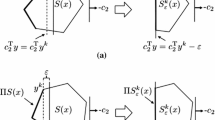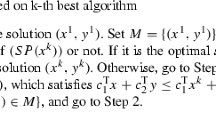Abstract
We consider mixed integer bilevel linear optimization problems in which the decision variables of the lower-level (follower’s) problem are all binary. We propose a general modeling and solution framework motivated by the practical reality that in a Stackelberg game, the follower does not always solve their optimization problem to optimality. They may instead implement a locally optimal solution with respect to a given upper-level decision. Such scenarios may occur when the follower’s computational capabilities are limited, or when the follower is not completely rational. Our framework relaxes the typical assumption of perfect rationality that underlies the standard modeling framework by defining a hierarchy of increasingly stringent assumptions about the behavior of the follower. Namely, at level k of this hierarchy, it is assumed that the follower produces a k-optimal solution. Associated with this hierarchy is a hierarchy of upper and lower bounds that are in fact valid for the classical case in which complete rationality of the follower is assumed. Two mixed integer linear programming (MILP) formulations are derived for the resulting optimization problems. Extensive computational results are provided to demonstrate the effectiveness of the proposed MILP formulations and the quality of the bounds produced. The latter are shown to dominate the standard approach based on a single-level relaxation at a reasonable computational cost. Finally, we also explore a class of bilevel problems for which 2-optimal lower-level solutions imply global optimality, and hence we can solve these bilevel problems exactly using the developed MILP formulations.


Similar content being viewed by others
Data availability statement
The data used during this study are publicly available with doi 10.5281/zenodo.6972912 at https://github.com/xyshi25/BilevelBounds
Code availability statement
The code used during this study are publicly available with doi 10.5281/zenodo.6972912 at https://github.com/xyshi25/BilevelBounds
References
Colson, B., Marcotte, P., Savard, G.: An overview of bilevel optimization. Ann. Oper. Res. 153(1), 235–256 (2007)
Dempe, S.: Foundations of Bilevel Programming. Kluwer Academic Publishers, Dordrecht (2002)
Moore, J.T., Bard, J.F.: The mixed integer linear bilevel programming problem. Oper. Res. 38(5), 911–921 (1990)
Lozano, L., Smith, J.C.: A value-function-based exact approach for the bilevel mixed-integer programming problem. Oper. Res. 65(3), 768–786 (2017)
Tahernejad, S., Ralphs, T.K., DeNegre, S.T.: A branch-and-cut algorithm for mixed integer bilevel linear optimization problems and its implementation. Math. Program. Comput. 12(4), 529–568 (2020)
Wang, L., Xu, P.: The watermelon algorithm for the bilevel integer linear programming problem. SIAM J. Optim. 27(3), 1403–1430 (2017)
Fischetti, M., Ljubić, I., Monaci, M., Sinnl, M.: Interdiction games and monotonicity, with application to knapsack problems. INFORMS J. Comput. 31(2), 390–410 (2019)
Fischetti, M., Ljubić, I., Monaci, M., Sinnl, M.: On the use of intersection cuts for bilevel optimization. Math. Program. 172(1–2), 77–103 (2018)
Sinha, A., Malo, P., Deb, K.: A review on bilevel optimization: from classical to evolutionary approaches and applications. IEEE Trans. Evol. Comput. 22(2), 276–295 (2017)
Vicente, L., Savard, G., Judice, J.: Discrete linear bilevel programming problem. J. Optim. Theory Appl. 89(3), 597–614 (1996)
Borrero, J.S., Prokopyev, O.A., Sauré, D.: Sequential interdiction with incomplete information and learning. Oper. Res. 67(1), 72–89 (2019)
De Negre, S.: Interdiction and discrete bilevel linear programming. Ph.D. thesis, Lehigh University (2011)
Israeli, E., Wood, R.K.: Shortest-path network interdiction. Netw. Int. J. 40(2), 97–111 (2002)
Brotcorne, L., Labbé, M., Marcotte, P., Savard, G.: A bilevel model for toll optimization on a multicommodity transportation network. Transp. Sci. 35(4), 345–358 (2001)
Labbé, M., Marcotte, P., Savard, G.: A bilevel model of taxation and its application to optimal highway pricing. Manag. Sci. 44(12–part–1), 1608–1622 (1998)
Beheshti, B., Prokopyev, O.A., Pasiliao, E.L.: Exact solution approaches for bilevel assignment problems. Comput. Optim. Appl. 64(1), 215–242 (2016)
Gao, Z., Wu, J., Sun, H.: Solution algorithm for the bi-level discrete network design problem. Transport. Res. Part B Methodol. 39(6), 479–495 (2005)
Xu, H., Zhang, Y., Cassandras, C.G., Li, L., Feng, S.: A bi-level cooperative driving strategy allowing lane changes. arXiv preprint arXiv:1912.11495 (2019). https://arxiv.org/abs/1912.11495. Accessed 9 Apr 2020
Audet, C., Hansen, P., Jaumard, B., Savard, G.: Links between linear bilevel and mixed 0–1 programming problems. J. Optim. Theory Appl. 93(2), 273–300 (1997)
Zare, M.H., Borrero, J.S., Zeng, B., Prokopyev, O.A.: A note on linearized reformulations for a class of bilevel linear integer problems. Ann. Oper. Res. 272(1–2), 99–117 (2019)
Zeng, B., An, Y.: Solving bilevel mixed integer program by reformulations and decomposition. Optimization online (2014). http://www.optimization-online.org/DB_FILE/2014/07/4455.pdf. Accessed 9 Apr 2020
Tahernejad, S., Ralphs, T.K.: Valid inequalities for mixed integer bilevel optimization problems. COR@L Laboratory Report 20T-013 (2020). https://coral.ise.lehigh.edu/~ted/files/papers/MibSCuts20. Accessed 7 June 2021
Caprara, A., Carvalho, M., Lodi, A., Woeginger, G.J.: Bilevel knapsack with interdiction constraints. INFORMS J. Comput. 28(2), 319–333 (2016)
IBM: ILOG CPLEX Optimization Studio (12.8) (2017). https://www.ibm.com/products/ilog-cplex-optimization-studio. Accessed 9 Apr 2020
Tang, Y., Richard, J.P.P., Smith, J.C.: A class of algorithms for mixed-integer bilevel min-max optimization. J. Global Optim. 66(2), 225–262 (2016)
Della Croce, F., Scatamacchia, R.: An exact approach for the bilevel knapsack problem with interdiction constraints and extensions. Math. Program. (to appear) (2020)
Hamming, R.W.: Coding and Information Theory. Prentice-Hall Inc. (1986)
Aarts, E., Aarts, E.H., Lenstra, J.K.: Local Search in Combinatorial Optimization. Princeton University Press, Princeton (2003)
Chandra, B., Karloff, H., Tovey, C.: New results on the old k-opt algorithm for the traveling salesman problem. SIAM J. Comput. 28(6), 1998–2029 (1999)
Gutin, G., Punnen, A.P.: The Traveling Salesman Problem and Its Variations, vol. 12. Kluwer Academic Publishers, New York (2004)
Bräysy, O., Gendreau, M.: Vehicle routing problem with time windows, part I: route construction and local search algorithms. Transp. Sci. 39(1), 104–118 (2005)
Psaraftis, H.N.: k-interchange procedures for local search in a precedence-constrained routing problem. Eur. J. Oper. Res. 13(4), 391–402 (1983)
Savelsbergh, M.W.: Local search in routing problems with time windows. Ann. Oper. Res. 4(1), 285–305 (1985)
Katayama, K., Hamamoto, A., Narihisa, H.: An effective local search for the maximum clique problem. Inf. Process. Lett. 95(5), 503–511 (2005)
Kernighan, B.W., Lin, S.: An efficient heuristic procedure for partitioning graphs. Bell Syst. Tech. J. 49(2), 291–307 (1970)
Maheswaran, R.T., Pearce, J.P., Tambe, M.: Distributed algorithms for dcop: a graphical-game-based approach. In: ISCA PDCS, pp. 432–439 (2004)
Schäffer, A.A.: Simple local search problems that are hard to solve. SIAM J. Comput. 20(1), 56–87 (1991)
Atamtürk, A., Nemhauser, G.L., Savelsbergh, M.W.: The mixed vertex packing problem. Math. Program. 89(1), 35–53 (2000)
Günlük, O., Pochet, Y.: Mixing mixed-integer inequalities. Math. Program. 90(3), 429–457 (2001)
Zhao, M., Huang, K., Zeng, B.: A polyhedral study on chance constrained program with random right-hand side. Math. Program. 166(1–2), 19–64 (2017)
Smith, J.C., Lim, C., Sudargho, F.: Survivable network design under optimal and heuristic interdiction scenarios. J. Global Optim. 38(2), 181–199 (2007)
Zare, M.H., Prokopyev, O.A., Sauré, D.: On bilevel optimization with inexact follower. Decis. Anal. 17(1), 74–95 (2020)
Jeroslow, R.G.: The polynomial hierarchy and a simple model for competitive analysis. Math. Program. 32(2), 146–164 (1985)
Lodi, A., Ralphs, T.K., Woeginger, G.J.: Bilevel programming and the separation problem. Math. Program. 146(1–2), 437–458 (2014)
Horst, R., Pardalos, P.M., Van Thoai, N.: Introduction to Global Optimization. Kluwer Academic Publishers, Dordrecht (2000)
Luedtke, J., Ahmed, S., Nemhauser, G.L.: An integer programming approach for linear programs with probabilistic constraints. Math. Program. 122(2), 247–272 (2010)
Lee, J., Ryan, J.: Matroid applications and algorithms. ORSA J. Comput. 4(1), 70–98 (1992)
Lawler, E.L.: Combinatorial Optimization: Networks and Matroids. Courier Corporation, New York (2001)
Oxley, J.: What is a matroid. Cubo 5, 179–218 (2003)
White, N., White, N.M.: Matroid Applications, vol. 40. Cambridge University Press (1992)
Caprara, A., Carvalho, M., Lodi, A., Woeginger, G.J.: A study on the computational complexity of the bilevel knapsack problem. SIAM J. Optim. 24(2), 823–838 (2014)
Ahuja, R.K., Magnanti, T.L., Orlin, J.B., Reddy, M.: Applications of network optimization. In: Ball, M., Magnanti, T., Monma, C., Nemhauser, G. (eds.) Handbooks in Operations Research and Management Science, vol. 7, pp. 1–83. Elsevier, Amsterdam (1995)
Frederickson, G.N., Solis-Oba, R.: Increasing the weight of minimum spanning trees. J. Algorithms 33(2), 244–266 (1999)
Shi, X., Zeng, B., Prokopyev, O.A.: On bilevel minimum and bottleneck spanning tree problems. Networks 74(3), 251–273 (2019)
Wei, N., Walteros, J.L., Pajouh, F.M.: Integer programming formulations for minimum spanning tree interdiction. Optimization online (2019). http://www.optimization-online.org/DB_FILE/2019/08/7325.pdf. Acessed 9 April 2020
Kis, T., Kovács, A.: On bilevel machine scheduling problems. OR Spectrum 34(1), 43–68 (2012)
Martello, S., Pisinger, D., Toth, P.: Dynamic programming and strong bounds for the 0–1 knapsack problem. Manag. Sci. 45(3), 414–424 (1999)
Garey, M.R., Johnson, D.S.: Computers and Intractability: A Guide to the Theory of NP-Completeness. W. H. Freeman, New York (2002)
Bazgan, C., Toubaline, S., Tuza, Z.: The most vital nodes with respect to independent set and vertex cover. Discrete Appl. Math. 159(17), 1933–1946 (2011)
Leskovec, J., Sosič, R.: Snap: a general-purpose network analysis and graph-mining library. ACM Trans. Intell. Syst. Technol. 8(1), 1 (2016)
Magnanti, T.L., Wolsey, L.A.: Optimal trees. In: Ball, M., Magnanti, T., Monma, C., Nemhauser, G. (eds.) Network Models, Handbooks in Operations Research and Management Science, vol. 7, pp. 503–615. Elsevier (1995)
Koch, T., Martin, A., Voß, S.: Steinlib: an updated library on steiner tree problems in graphs. In: Cheng, X.Z., Du, D.Z. (eds.) Steiner Trees in Industry, pp. 285–325. Springer, Boston (2001)
Acknowledgements
The authors would like to thank the Review Team for their helpful and constructive comments.
Funding
This research is based upon work supported by the Office of Naval Research [Grant N00014-19-1-2330].
Author information
Authors and Affiliations
Corresponding author
Ethics declarations
Conflict of interest
The authors declare that they have no conflict of interest.
Additional information
Publisher's Note
Springer Nature remains neutral with regard to jurisdictional claims in published maps and institutional affiliations.
Rights and permissions
Springer Nature or its licensor (e.g. a society or other partner) holds exclusive rights to this article under a publishing agreement with the author(s) or other rightsholder(s); author self-archiving of the accepted manuscript version of this article is solely governed by the terms of such publishing agreement and applicable law.
About this article
Cite this article
Shi, X., Prokopyev, O.A. & Ralphs, T.K. Mixed integer bilevel optimization with a k-optimal follower: a hierarchy of bounds. Math. Prog. Comp. 15, 1–51 (2023). https://doi.org/10.1007/s12532-022-00227-z
Received:
Accepted:
Published:
Issue Date:
DOI: https://doi.org/10.1007/s12532-022-00227-z




